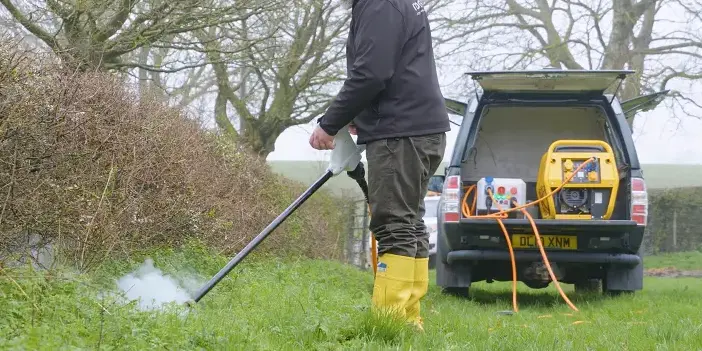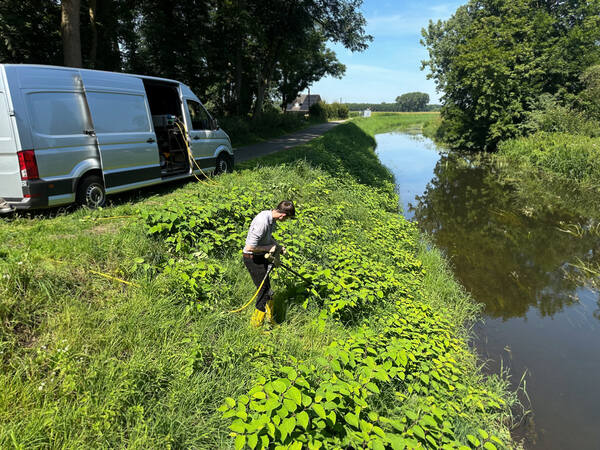Invasive Weeds Management

Invasive Weeds Management
Effective Electric Weed Control for Invasive Species
Invasive weeds like Japanese Knotweed and Giant Hogweed present serious risks to both ecosystems and infrastructure. These fast-spreading plants displace native species, weaken building foundations, and obstruct drainage systems. Additionally, they create safety hazards in public spaces, such as parks, where contact with toxic plants like Giant Hogweed can cause severe injuries. Effective management of these species is crucial to maintaining biodiversity and protecting property. Electric weed control offers an innovative, efficient solution by using high voltage to eliminate weeds systemically, targeting their root systems and preventing regrowth. This method is especially effective on invasive species such as Japanese Knotweed and Giant Hogweed, making it a powerful tool for long-term management of these resilient plants.
Why Use Electric Weed Control?
Invasive species like Japanese Knotweed and Giant Hogweed are incredibly resilient, with deep root systems that make them difficult to eradicate using traditional methods. Left unmanaged, these plants can cause severe damage to both the environment and human infrastructure. Japanese Knotweed, for instance, is notorious for its ability to grow through concrete and damage building foundations, while Giant Hogweed poses significant health risks due to its toxic sap, which can cause severe burns and blindness. Electric weed control is a highly effective solution because it kills the plant systemically, targeting not only the visible parts but also the deep root structures that allow these species to thrive.
How Electric Weed Control Works
Electric weed control uses high-voltage electric pulses to penetrate the plant, boiling the water within its cells and destroying its structure. This method damages the plant’s chlorophyll, disrupts its water supply, and causes it to dry out and die. By attacking the roots, it prevents regrowth, making it particularly effective for deep-rooted species like Japanese Knotweed.
The Kersten Electric Weedkiller offers adjustable voltage settings to tackle different plant types effectively. For shallow-rooted plants, the Zap Weeder is ideal, as it delivers a quick kill with high voltage. In contrast, deeper-rooted species like Japanese Knotweed require the Kersten Electric Weeder, which applies a lower voltage over a longer duration to ensure the entire root system is affected. This systemic approach is crucial for long-term management, as invasive plants can easily regrow if any portion of their roots remains intact.
The Long-Term Effects of Electric Weed Control
Electric weed control provides an immediate solution and long-term prevention by ensuring that the plant’s root system is destroyed. Once treated, the invasive plant loses its ability to regrow, significantly reducing the need for repeat treatments. For aggressive species like Japanese Knotweed, repeated electric treatments over a few seasons can eradicate the plant entirely, preventing further damage to property and ecosystems. Giant Hogweed, which can spread through its toxic seeds, is also effectively managed by using electric weeding to destroy its reproductive parts, reducing its ability to spread.
Articles about Invasive Weeds Management
No, you don’t need to burn the target weed for the device to be effective. The electricity generates heat that boils the weeds from the inside out, destroying the plant’s structure. While you won’t see immediate results, you may hear a ‘pop’ sound indicating that the plant is being boiled. The plant will appear to be decaying, and eventually dry out and decompose within two weeks.
Yes, the electric weeder does require special training to operate. Most products need operators to undergo annual certified application training. This training covers how to use the latest models and includes important safety protocols, especially for operating in public areas.
Targeted Application: Electric weed control, especially with products like those from Kersten and Zasso, allows for precise application. The Zasso Zap Weeder has electrodes closer together, making it ideal for shallower-rooted plants on hard surfaces.
Electric weed control uses electricity to generate heat, which can reach temperatures up to 100°C. When this heat is applied to plants, it disrupts their chlorophyll, leading to its degradation. Chlorophyll is vital for photosynthesis, and temperatures as low as 45-50°C can cause it to start breaking down. At temperatures around 70°C or higher, the plant’s ability to conduct photosynthesis is severely impaired. Chlorophyll is essential for photosynthesis, and when it is damaged by heat, the plant loses its ability to convert sunlight into energy. As a result, the plant cannot produce food, and it eventually dies.
No, you don’t need to burn the target weed for the device to be effective. The electricity generates heat that boils the weeds from the inside out, destroying the plant’s structure. While you won’t see immediate results, you may hear a ‘pop’ sound indicating that the plant is being boiled. The plant will appear to be decaying, and eventually dry out and decompose within two weeks.
Yes, the electric weeder does require special training to operate. Most products need operators to undergo annual certified application training. This training covers how to use the latest models and includes important safety protocols, especially for operating in public areas.
Targeted Application: Electric weed control, especially with products like those from Kersten and Zasso, allows for precise application. The Zasso Zap Weeder has electrodes closer together, making it ideal for shallower-rooted plants on hard surfaces.
The Walk-Behind Electric Weeder is ideal for use on hard surfaces like driveways, pavements, block paving, and patios. It can effectively remove weeds growing in between cracks or on the surface without damaging the underlying material or cables. For more details on suitable surfaces and tips on usage, visit our Electric Weeder page.
Electric weed control uses electricity to generate heat, which can reach temperatures up to 100°C. When this heat is applied to plants, it disrupts their chlorophyll, leading to its degradation. Chlorophyll is vital for photosynthesis, and temperatures as low as 45-50°C can cause it to start breaking down. At temperatures around 70°C or higher, the plant’s ability to conduct photosynthesis is severely impaired. Chlorophyll is essential for photosynthesis, and when it is damaged by heat, the plant loses its ability to convert sunlight into energy. As a result, the plant cannot produce food, and it eventually dies.


.jpg)